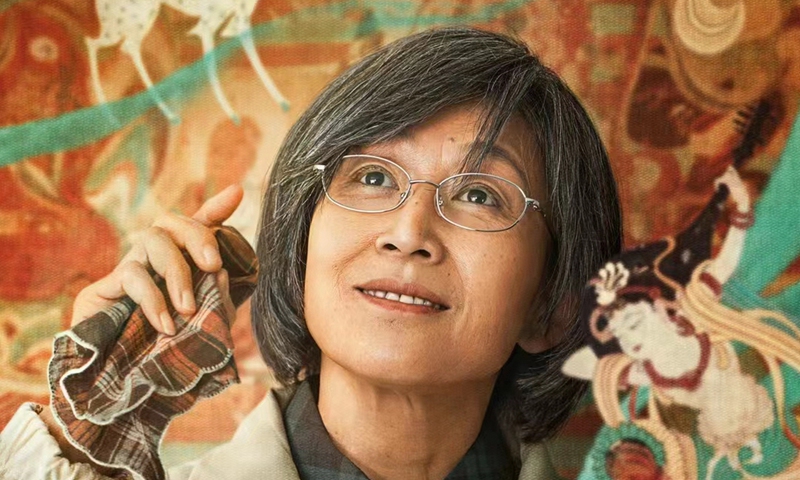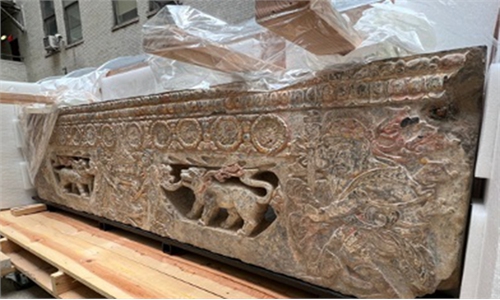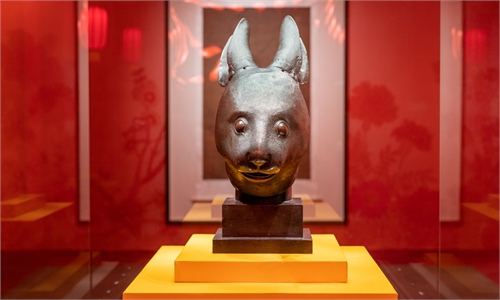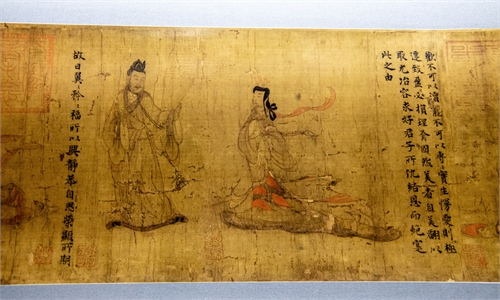ARTS / CULTURE & LEISURE
Film renews call to return Chinese relics

Poster of the film Great Love Dunhuang Photo: IC
Wang is remembered as the man who discovered the Library Cave at the site, a repository of over 50,000 items dating back to the 4th to the 11th century. Regrettably, only 30 percent of the Library Cave relics remain in China today.
British explorer Marc Aurel Stein was the first foreigner to purchase a large volume of manuscripts, painting, textiles and prints from Wang at a very low price by deceitfully claiming he was an envoy from the West. Though some have labeled Stein as merely a thief, it is crucial to recognize that he was a highly educated scholar. Rather than a common thief, Stein was exploiting his knowledge for profit in China.
According to Professor Wang Jiqing of Lanzhou University, Stein smuggled over 140 bundles of items in the summer of 1907 and a further 230 bundles in October that year, before shipping the unlawfully acquired items to the UK. Currently, the relics are mainly kept in the British Museum, the British Library and the V&A Museum in London.
While acknowledging the dedicated efforts of contemporary British cultural heritage professionals in preserving certain artifacts, it is essential to understand that this is not universally applied. Many items originating from China held in foreign collections are often relegated to dark corners, lacking the attention they deserve.
After around 2,000 artifacts were stolen from the British Museum, one of the UK's most prestigious cultural institutions, in August, Chinese are again calling for the return of the stolen items as they can no longer be well taken care of overseas.
In contrast, Aoyama Keiji, son of Japanese calligrapher Aoyama Sanu, has set a commendable example for British cultural bodies. Following his father's last wishes, Aoyama returned a portion of a long scroll his father preserved to the Dunhuang Academy. The scroll is a tally book of the local government in the late Tang Dynasty (618-907).
The scroll was once torn into three parts. Aoyama returned the middle section, while the right section is in the Dunhuang Academy collection. Meanwhile, the left section remains in France. The return of the middle section has unveiled something new as the reverse side of the scroll contains annotations of the Diamond Sutra that date back to the Tang Dynasty, a revelation that pushed the artifact's age back a century.
Aoyama's gesture highlights the potential for cultural restitution when individuals understand the importance of returning artifacts to their place of origin. Items that the British institutions may not be able to safeguard adequately can be better protected and valued in China. Moreover, the holistic return of scattered relics to their place of origin is a mark of respect for academic research, allowing the artifacts to contribute to a more complete understanding of history.
While immediate repatriation may not be feasible due to Britain's domestic rules and other challenges, voices advocating for the return of these artifacts will not cease, as it is not only China, but also countries like Egypt, Syria and Greece that are calling for the return of relics looted or illegally acquired by Britain. The conversation about the rightful ownership and protection of cultural heritage is one that transcends borders and cultures.
The case of Stein's acquisitions prompts a reflection on the ethics of historical acquisitions. At the turn of the 20th century, colonial powers often exploited their influence and technological superiority to acquire cultural artifacts from regions with less developed defenses. The narrative of those times does not absolve the actions of individuals like Stein and thus makes the UK take possession of thousands of Chinese relics unethically and unlawfully.
In the present day, there is a growing global awareness of the need for cultural restitution. Countries are revisiting their historical collections and engaging in dialogues with nations from which these artifacts originated. The return of cultural artifacts is not just a legal or ethical matter, it is a step toward fostering international understanding and collaboration.
The journey toward cultural restitution is undoubtedly complex as it involves navigating legal frameworks, addressing historical injustices, and fostering a spirit of collaboration between countries. However, it is a journey that deserves to be undertaken, as it contributes to the healing of historical wounds and promotes a shared appreciation of humanity's cultural heritage.
The case of Stein and the artifacts from Dunhuang prompt reflection on historical acquisitions and their implications for contemporary cultural relations. The global community must strive for a future where cultural heritage is respected, preserved, and shared across borders, fostering a more inclusive and understanding world.
The author is a reporter with the Global Times. life@globaltimes.com.cn



